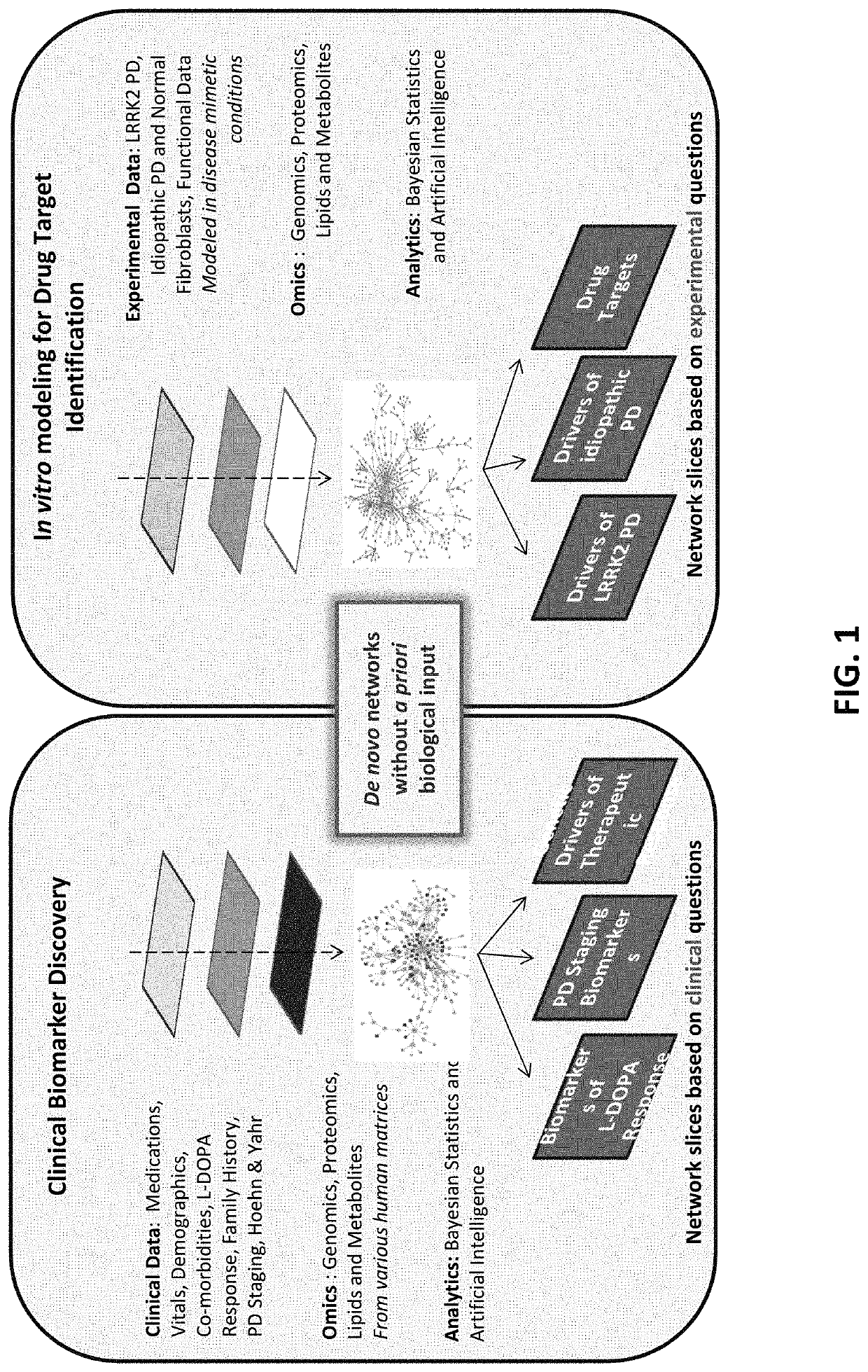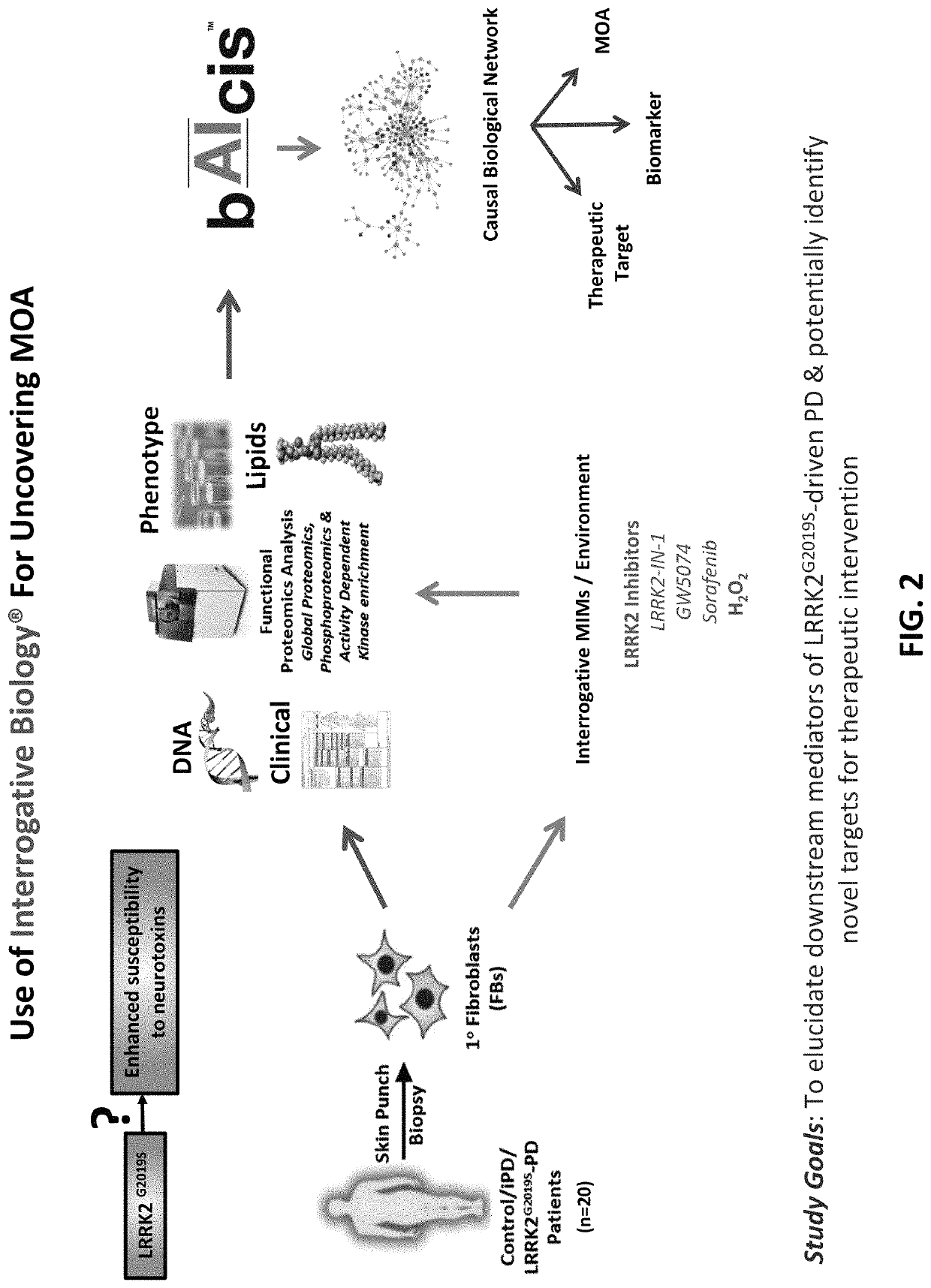Methods for treating Parkinson's disease
a parkinson's disease and treatment method technology, applied in the field of parkinson's disease treatment methods, can solve the problems of a significant risk of pd from heterozygote mutations
- Summary
- Abstract
- Description
- Claims
- Application Information
AI Technical Summary
Benefits of technology
Problems solved by technology
Method used
Image
Examples
example 1
ation of GBA and PIG3 as Therapeutic Targets for PD
[0123]In this example, the Interrogative Biology™ Platform illustrated in FIG. 1 and described in detail at least in international Publication Nos. WO 2012 / 119129 and WO2013 / 151577, the entire contents of each of which are hereby incorporated herein by reference, was used to study Parkinson's Disease. The technology utilized proteomics techniques for measuring protein activity related to pathogenesis of Parkinson's Disease and the direct effects of that activity on the proteome, thereby providing a system that can be used to understand causal relationships between various proteins in the context of global changes in the cellular proteome in Parkinson's Disease.
[0124]In a typical experiment, a model is first established in accordance with the platform technology, in which cells representative of Parkinson's Disease are interrogated by exposure to an environmental perturbation. A control is provided for comparison. Second, enzyme acti...
example 2
ession is Associated with Rotenone-Induced Apoptosis in a Human Dopaminergic Cell Line
[0128]The purpose of this experiment was to evaluate the expression of PIG3 and cell viability in an in vitro chemical model of Parkinson's Disease. The in vitro model involved the use of a human dopaminergic cell line, SH-SY5Y, treated with rotenone. Rotenone is known to induce death of dopaminergic neurons in experimental animals, and injection of rotenone into rats was reported to cause the development of symptoms similar to those of Parkinson's Disease (PD) (Betarbet et al., 2000, Nature Neuroscience 3:1301; Caboni et al., 2004, Chem. Res. Toxicol. 17(11):1540-8). The structure of rotenone is show below:
[0129]
[0130]For the experiment, SH-SY5Y cells were treated with rotenone at a concentration of 0, 50, 100 and 500 nm for 48 hours. Following the treatment, the amount of PIG3 protein in the cells and the extent of SH-SY5Y cell death were assessed. Cells treated with etoposide, which is known to ...
example 3
ession is Associated with 6-OHDA-Induced Apoptosis in a Human Dopaminergic Cell Line
[0133]This experiment was similar to the experiment described in Example 1, except that the in vitro chemical model of Parkinson's Disease involved treatment of SH-SY5Y cells with oxidopamine, also known as 6-hydroxydopamine (6-OHDA) or 2,4,5-trihydroxyphenethylamine 6-OHDA is known to have a selective adverse effect on dopaminergic and noradrenergic neurons. The structure of 6-OHDA is shown below:
[0134]
[0135]For the experiment, SH-SY5Y cells were treated with 6-OHDA at a concentration of 0, 50 and 100 μm for 48 hours. Following the treatment, the amount of PIG3 protein in the cells and the extent of SH-SY5Y cell death were assessed. Cells treated with etoposide were used as a positive control. Apoptosis in the treated cells was assessed by measuring the amount of cleaved poly(ADP-ribose) polymerase (PARP).
[0136]FIG. 8, Panel A is a representative immunoblot showing the amounts of PIG3 and cleaved PA...
PUM
| Property | Measurement | Unit |
|---|---|---|
| molecular weight | aaaaa | aaaaa |
| size | aaaaa | aaaaa |
| frequency | aaaaa | aaaaa |
Abstract
Description
Claims
Application Information
 Login to View More
Login to View More - R&D
- Intellectual Property
- Life Sciences
- Materials
- Tech Scout
- Unparalleled Data Quality
- Higher Quality Content
- 60% Fewer Hallucinations
Browse by: Latest US Patents, China's latest patents, Technical Efficacy Thesaurus, Application Domain, Technology Topic, Popular Technical Reports.
© 2025 PatSnap. All rights reserved.Legal|Privacy policy|Modern Slavery Act Transparency Statement|Sitemap|About US| Contact US: help@patsnap.com



